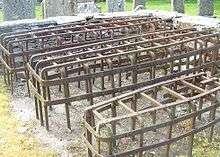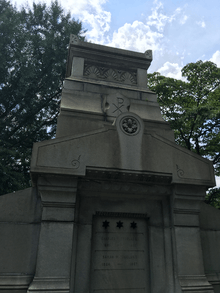Grave robbery
Grave robbery, tomb robbing, or tomb raiding is the act of uncovering a grave, tomb or crypt to steal matter. It is usually perpetrated to take and profit from valuable artefacts or personal effects.[n 1] A related act is body snatching, a term denoting the contested or unlawful taking of a body (seldom from a grave), which can be extended to the unlawful taking of organs alone.
Grave robbing has caused great difficulty to the studies of archaeology, art history, and history.[1][2] Countless precious grave sites and tombs have been robbed before scholars were able to examine them. In any way, the archaeological context and the historical and anthropological information are destroyed:
Looting obliterates the memory of the ancient world and turns its highest artistic creations into decorations, adornments on a shelf, divorced from historical context and ultimately from all meaning.[3]
Grave robbers who are not caught usually sell relatively modern items anonymously and artifacts on the black market. Those intercepted, in a public justice domain, are inclined to deny their guilt due to the three stigmas mentioned. Though some artifacts may make their way to museums or scholars, the majority end up in private collections.[4]
Effects on archaeology around the world
China
Grave robbing in China is a practice stretching back to antiquity; the classic Chinese text Lüshi Chunqiu, dating to the 2nd century BCE, advised readers to plan simple burials to discourage looting.[5] The presence of jade burial suits and other valuables in tombs were powerful temptations to rob graves.[6]
In modern China, grave robbing has been perpetrated by both amateurs (such as farmers and migrant laborers) and by professional thieves associated with transnational criminal networks.[5] The practice reached epidemic proportions in the 1980s, as the development and construction boom following the Chinese economic reform led to many archaeological sites being revealed.[5] Other peaks of tomb robbing occurred in the early 2000s and in the 2010s, when the plunder of graves was on the upswing due to an increase in global and domestic demand (and prices) for Chinese antiquities.[5] The provinces of Henan, Shaanxi, and Shanxi were particularly affected by tomb robbing.[5]
Africa
Ancient Egyptian tombs are one of the most common examples of tomb or grave robbery. Most of the tombs in Egypt's Valley of the Kings were robbed within one hundred years of their sealing (including the tomb of the famous King Tutankhamen, which was raided at least twice before it was discovered in 1922).[7] As most of the artifacts in these ancient burial sites have been discovered, it is through the conditions of the tombs and presumed articles that are missing in which historians and archaeologists are able to determine whether the tomb has been robbed. Egyptian pharaohs often kept records of the precious items in their tombs, so an inventory check is presumed for archaeologists.[8] Oftentimes, warnings would be left by the Pharaohs in the tombs of calamities and curses that would be laid upon any who touched the treasure, or the bodies, which did little to deter grave robbers. There are many examples of grave robbing in the Ancient World outside of Egypt.[9]
Classical Antiquity
The Romans (Byzantium) also suffered decades of theft and destruction of tombs, crypts, and graves.[10]
Europe
In parts of Europe, graves are robbed on an accelerating and alarming scale. Many grave robbers work with metal detectors and some of the groups are organised criminals, feeding the black market with highly prized archaeological artifacts.[11]
Merovingian graves in France and Germany and Anglo-Saxon graves in England contain many metal grave goods, mostly of iron. Grave robbers often leave them, being only interested in gold and silver. Grave contexts, ceramics, iron weapons and skeletons are destroyed.
In Eastern Europe, including Southeast Europe and the European part of Russia, grave robbers target all kinds of historically important graves, from pre-historic tombs to World War II graves.[12][13][11]
North America
Modern grave robbing in North America also involves long-abandoned or forgotten private Antebellum Period to pre-Great Depression era grave sites. These sites are often desecrated by grave robbers in search of old, hence valuable, jewelry. Affected sites are typically in rural, forested areas where once-prominent, wealthy landowners and their families were interred. The remote and often undocumented locations of defunct private cemeteries make them particularly susceptible to grave robbery. The practice may be encouraged by default upon the discovery of a previously unknown family cemetery by a new landowner.
One historical incident occurred during the evening of November 7, 1876, when a group of counterfeiters tried to abscond with Abraham Lincoln's mortal remains from his grave in Springfield, Illinois, in order to secure the release of their imprisoned leader, counterfeit engraver Benjamin Boyd. However, a secret service agent was present and had notified the police beforehand, so the attempted grave robbers only succeeded in the dislodgment of the lid of his coffin. As a consequence, when reburied, additional security measures prevented further depredations against Lincoln's body [14][15]
Central America
Grave robbers often sold stolen Aztec or Mayan goods on the black market for an extremely high price. The buyers (museum curators, historians, etc.) did not often suffer the repercussions of being in possession of stolen goods and that the blame (and charges) are put upon the lower-class grave robbers. Today's antiquities trade has become a streamlining industry – and the speed these artifacts enter the market has grown exponentially. Laws have been enacted in these regions, but due to extreme poverty, these grave robbings continue to grow each year.
Race
African Americans
Enslaved and free blacks, immigrants, and the poor were frequently the target of grave robbing.
— Edward C. Halperin
African Americans would often bury their dead in a potter's field; not having the access or money for a proper funeral. When buried in potter's fields, the dead were not normally buried very deep. A grave robber could just wait in the distance until everyone left and dig up the body from its shallow grave.[16]
Once the railroad was invented and tracks laid—the sale of African American slaves from the South for dissection began; being sent to medical schools in the northern part of the United States. One Professor of Anatomy in New England reported that, in the 1880s and 1890s, he entered into an arrangement in which he received, twice each semester, a shipment of 12 bodies of southern African Americans. "They came in barrels labeled turpentine and were shipped to a local hardware store that dealt in painting materials".[17]
After the Emancipation Act, African American Union soldiers that died while serving in the military were dissected by white military surgeons.[18]
State laws in Mississippi and North Carolina were passed in the 19th century which allowed medical schools to use the remains of those at the bottom of society's hierarchy—the unclaimed bodies of poor persons, residents of alms houses, and those buried in potter's fields.[19][20] The option to dissect Confederate soldiers was also not available, being that Mississippi and North Carolina legally released the bodies to the families. The North Carolina law also provided that the body of whites never be sent to an African American medical college (such as the Leonard Medical School). These African American Medical schools typically obtained unclaimed Black ‘‘potter’s field bodies’’.[21]
Deterrents
Geography

The geography and placement of burial grounds became a deterrent within itself. This is because without the accessibility of the automobile (in the early 19th century), the transportation of bodies was difficult.
A perfect example of this is Mount Auburn Cemetery,[22] in Cambridge Massachusetts. It was the first rural cemetery inside the United States. The rural location of the cemetery created transportation issues. In addition, the terrain of and around the cemetery was formidable. Further, Henry Alexander Scammell Dearborn, the designer wanted to leave the natural terrain (including ponds and hills) within the cemetery. If someone wanted to rob a grave, they would have to maneuver around these obstacles and navigate large stretches of land in the dark. Note that Mount Auburn Cemetery is over 175 acres.[23] Other cemeteries, of the time, that were originally built away from populated areas for similar reasons, include: Mount Hope Cemetery in Bangor, Maine (1834); Laurel Hill Cemetery in Philadelphia, Pennsylvania (1836); Mount Pleasant Cemetery in Taunton, Massachusetts (1836); Mount Hope Cemetery in Rochester, New York (1838); Green-Wood Cemetery in Brooklyn, New York (1838); and, Green Mount Cemetery in Baltimore, Maryland (1838).
Mortsafes

A mortsafe or mort safe was an iron coffin or framework which helped to protect a grave by preventing the body from being dug up and taken away. Mortsafes were specific for the task of preventing bodies from being stolen for purposes of medical dissections.[24] These deterrents, used commonly in Scotland, would be only available for the rich to protect their loved ones, since iron was so expensive. After the body would decompose to a certain extent, the Mortsafe would be removed. These were not a commodity that were sold and bought; rather, they were rented.
Mort houses
A mort house or dead house was used to store bodies until decomposed enough to no longer be targets for grave robbing. Up to 31 recorded mort houses were scattered throughout Scotland and northern England.[25] Usually these structures were built within or near cemeteries to make transportation easier. Prior to grave robbers, they were used to store dead bodies in the winter, being that the ground was too cold and in some cases impossible to dig into. An example is the Udny Mort House built in 1832, Aberdeenshire, north-east Scotland and still standing today.
Coffin collars
The coffin collar was an iron collar often fixed to a piece of wood.[26] It was fixed around the neck of a corpse and then bolted to the bottom of a coffin. Most common reports of these collars being used came from Scotland around the 1820s.
Family mausoleums

Historically mausoleums have been used as a sign of a family's wealth and a symbol of gentry and nobility in many countries. In the mid and late 19th century in North America, more and more families began to buy mausoleums. The belief was that it would be easier for a Resurrectionist or grave robber to dig up a grave rather than to topple down iron or steel doors guarding the mausoleum. A flaw in the design of the mausoleum was the stained glass or other windows within. Almost every family between the 18th and 19th century had a religious affiliation. As such, many of these families (usually with a Christian affiliation) would put stained glass within the mausoleums. The grave robbers would then just have to smash the glass to break in and to retrieve the body. Making it even easier, around the 1830s families began to fear burying family members. The living relatives would stand guard inside the mausoleum and would sometimes get trapped—only to be discovered upon the death of the next family member. To remedy this, families would put a spare key somewhere within the mausoleum[27] and create doors with two way locks. In short, grave robbers could break a window, recover the body, find the key, and walk straight out the front door of the mausoleum.
Guards/guarding
One of the most simplistic and low-tech methods to prevent grave robbing were to have an individual guard over the newly buried body. This was done until decomposition of the body was brought to a point where they would no longer be desirable for medical use. If families did not have enough money to hire an individual to watch over the grave for a select number of days, the family would delegate this duty amongst them and close friends. As grave robbing became a lucrative business in the 19th century, a bribe would convince some guards to look the other way.[28]
Deception
Within the Great Pyramid of Giza (completed around 2560 BC),[29] an Egyptian deterrent system was built to guard the tomb of Pharaoh Khufu. This system consists of blocks and grooves to protect the King's Chamber from tomb robbers. Some experts believe that Pharaoh Khufu's tomb has actually not been found because of the deterrent system; instead, what had been found by grave robbers were fake rooms.[30]
Notes and References
- Notes
- Daniel (1950), p. 11
- Atwood (2004), p. 9
- Atwood (2004), p. 10
- Huffer, Damien; University, Stockholm; Graham, Shawn (2017). "The Insta-Dead: The rhetoric of the human remains trade on Instagram". Internet Archaeology (45). doi:10.11141/ia.45.5.
- Qin, Amy (July 15, 2017). "Tomb Robbing, Perilous but Alluring, Makes Comeback in China". New York Times.
- Paul van Els (2018). The Wenzi: Creativity and Intertextuality in Early Chinese Philosophy. Studies in the History of Chinese Texts. Brill. p. 12.
- Gardiner (2007), p. 147
- Gardiner (2007), p. 244
- Mueller, Tom (June 2016). "How Tomb Raiders Are Stealing Our History". National Geographic.
- Shelton (1998), p. 95
- Kraske, Marion (21 December 2007). "Bulgaria Plagued by 'Grave Robbers'". Spiegel Online. Retrieved 10 December 2017.
- "Rise of the Nazi-Grave Robbers". Bloomberg Businessweek. 23 August 2016. Retrieved 10 December 2017.
- "Grave robbing ghouls who trade in Nazi relics". Sunday Express. 8 September 2012. Retrieved 10 December 2017.
- Craughwell (2007)
- Keith Verinese: "The Adventures of Abraham Lincoln's Corpse:" http://io9.com/S898746/the-adventures-of-abraham-lincolns-corpse%5B%5D
- "History of African-American Cemeteries". www.sciway.net. Retrieved 31 July 2016.
- Waite, Frederick C. (1945). Grave robbing in New England. Public Library of Fort Wayne and Allen County.
- Savitt, Todd L. (November 1977). "Slave Life Insurance in Virginia and North Carolina". The Journal of Southern History. 43 (4): 583–600. doi:10.2307/2207007. JSTOR 2207007.
- Richardson, Ruth (2000). Death, Dissection and the Destitute (2 ed. with a new afterword. ed.). Chicago: The University of Chicago Press. ISBN 9780226712406.
- Humphrey, DC (September 1973). "Dissection and Discrimination: the Social Origins of Cadavers in America, 1760-1915". Bulletin of the New York Academy of Medicine. 49 (9): 819–27. PMC 1807060. PMID 4582559.
- Moore, Wendy (2005). The Knife Man : Blood, Body Snatching, and the Birth of Modern Surgery (1st pbk. ed.). New York: Broadway Books. ISBN 0767916530.
- "Mount Auburn Cemetery". mountauburn.org.
- "Mount Auburn Cemetery--Massachusetts Conservation: A Discover Our Shared Heritage Travel Itinerary". www.nps.gov. Retrieved 30 July 2016.
- Lennox, Suzie (2016-09-30). Bodysnatchers: Digging Up The Untold Stories of Britain's Resurrection Men. Barnsley, South Yorkshire: Pen and Sword History. p. 39,65. ISBN 9781473866577.
- Gorman, Martyn. "Map Showing the Distribution of Morthouses in Scottish Graveyards". www.abdn.ac.uk. University of Aberdeen. Retrieved 5 August 2016.
- "National Museums of Scotland - Coffin Collar". nms.scran.ac.uk. Retrieved 30 July 2016.
- "Mausoleum Locks (19th & 20th century)". Archived from the original on 26 March 2015. Retrieved 30 July 2016.
- Davis, Lauren. "8 Ways to Keep Body Snatchers from Stealing Your Corpse". Retrieved 6 August 2016.
- "The Great Pyramid of Giza: Last Remaining Wonder of the Ancient World". Ancient History Encyclopedia. Retrieved 6 August 2016.
- Jarus, Owen. "'Primitive Machine' Within Great Pyramid of Giza Reconstructed". Live Science. Retrieved 6 August 2016.
- References
- All three long-used terms bear their plain (natural) meaning, specifically that robbing and raiding in this context mean stealing. In English, Welsh and Scottish law "to rob"/"robbery" is limited to an intentional fright or attack against a person so as to steal - i.e. some form of assault or battery. In more common colloquial use the term "rob" is also used transitively with any type of place meaning to steal from. This means that, internationally, stealing of coffins/urns containing remains, components of these items or taking bodies from their proper, intended final resting place is also caught by the term
Bibliography
- Atwood, Roger (2004), Stealing History, Tomb Raiders, Smugglers, and the Looting of the Ancient World, New York City: St. Martin's Press
- Daniel, Glyn (1950), A Hundred and Fifty Years of Archaeology, Cambridge, Massachusetts: Harvard University Press
- Gardiner, Alan (2007) [1961], The Egyptians: An Introduction, Oxford: Oxford University Press (The Folio Society)
- Peters, Bernard C. (1997), "Indian-Grave Robbing at Sault Ste. Marie, 1826.", The Michigan Historical Review, 23 (2)
- Shelton, Jo-Ann (1998), As the Romans Did (2nd ed.), Oxford: Oxford University Press
- Craughwell, Thomas (2007), Stealing Lincoln's Body, Cambridge, Massachusetts: Harvard University Press
- Peet, T. E. (1930), The great Tomb-Robberies of the Twentieth Egyptian Dynasty, Oxford.
- Redman, Samuel (2016), Bone Rooms: From Scientific Racism to Human Prehistory in Museums, Cambridge, Massachusetts: Harvard University Press
- Lennox, Suzie (2016-09-30), Bodysnatchers: Digging Up The Untold Stories of Britain's Resurrection Men, Barnsley, South Yorkshire: Pen and Sword History, p. 39,65, ISBN 9781473866577